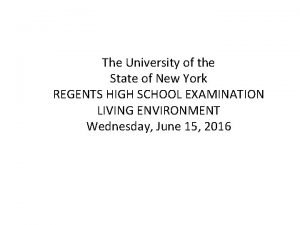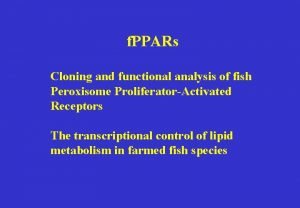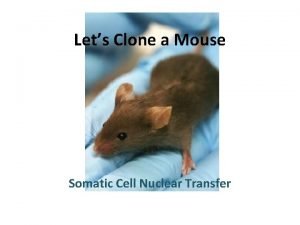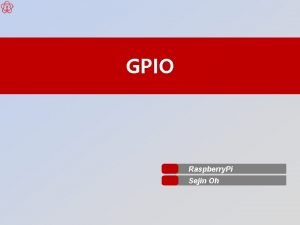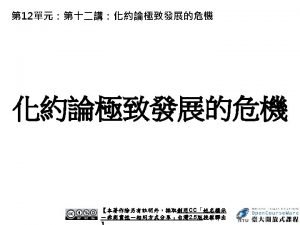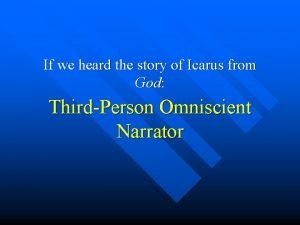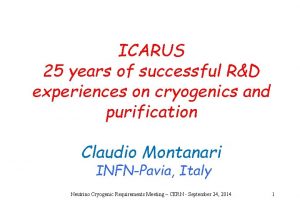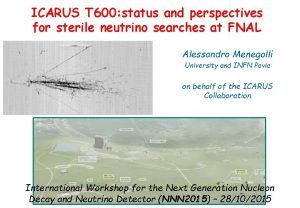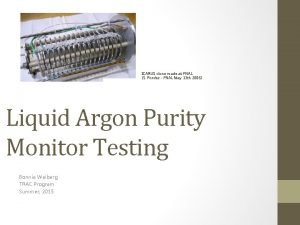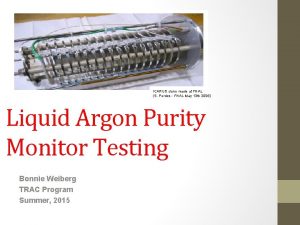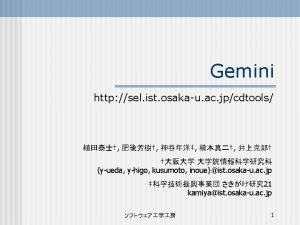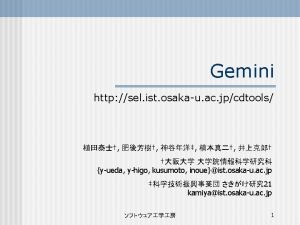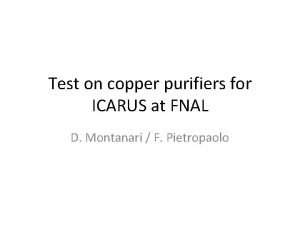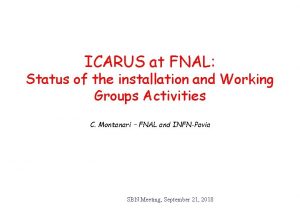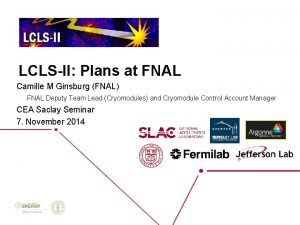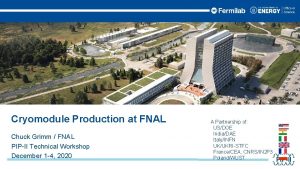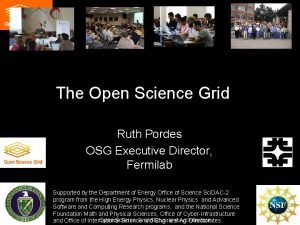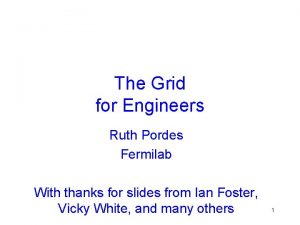ICARUS clone made at FNAL S Pordes FNAL






















- Slides: 22

ICARUS clone made at FNAL (S. Pordes - FNAL May 13 th 2006) Liquid Argon Purity Monitor Testing Bonnie Weiberg TRAC Program Summer, 2015

How I Spent my Summer Vacation, 2015

Purpose of My TRAC Project • Measuring the Anode and Cathode Signal Strength for the short – 45 cm – Liquid Argon Purity Monitor. • Analyzing the signals after the quartz optical fibers were cleaved using different devices. • To measure the signal difference when an extension fiber was added via a connection through a PEEK coupler. • This purity monitor will be installed in the 35 kiloton liquid argon cryostat as part of the DUNE Experiment.

Experimental Apparatus

Experimental Apparatus • The Short Purity Monitor is about 45 cm long. • Optical Fibers are made of Quartz, surrounded by A Polyimide buffer. • The Cathode is gold plated aluminum. • Photons travel through the Quartz fibers to the Cathode and eject electrons that then travel through the electric field to the Anode.

Experimental Apparatus • Xenon Flash lamp • Flash lamp is Newport/Oriel Model 6427 Xe, 3 x 2. 5 mm Large Bulb, 5 J, 60 W, 9 ms Pulse width, 60 Hz Flash lamp • Note that Au Work function is 5. 1 e. V • λ < 250 nm to extract an electron

Experimental Apparatus • Oscilloscope, Low and High Voltage • Arm provided by Dr. Alan Hahn, at no extra cost to the presentation. • ; )

Experimental Procedure #1 • After setting the Xenon Flash Lamp to 5000 m. J and 1 Hz, I adjusted the Cathode voltage to -100 Volts, and the Anode voltage to 400 Volts, producing an electric field of 500 Volts. • I inserted the three fibers into the fiber holder and when they were against the flash lamp, I recorded the peak signals for both the cathode and anode. I repeated this procedure five times, removing the fibers completely, then reinserting them into the holder. • I repeated the above procedure for each of the three individual fibers, five times each.

Experimental Procedure #1 • Anode Peak is here • Cathode Peak is here

Experimental Data Summary

Experimental Data Summary • After attaching a 1 foot fiber segment to fiber one using a PEEK coupler, the following data was collected:

Experimental Procedure #2 • To check the individual fibers for their light transmittance, each fiber was placed into a Photodiode and the current was measured.

Experimental Procedure #3 • The fiber holders were then rearranged inside the Photocathode to check for cathode integrity. • Their original order was: • Holders 1 & 3 were switched.

Experimental Data Summary

Experimental Procedure #4 • A new Photocathode was installed on July 7 th by Mark Ruschman. His fingers are visible on the right. • The system was returned to the vacuum chamber and the chamber evacuated. • Data was once again collected using the aforementioned procedure, with the same fibers, listed earlier.

Experimental Data Summary • After the apparatus sat for over a week, under vacuum, base line readings were again measured. Due to the new signal strength, the values are reported in Volts (V), not millivolts (m. V)!!!

Experimental Data Summary • A 32. 9 cm Extension of fiber was connected to the long optical fiber with a PEEK coupler, held in place with Teflon screws.

Experimental Conclusions • The Photodiode allowed for the checking of similar signals through each fiber. • Using a coupler produced a decrease in the cathode and anode signals. • Changing the Photocathode resulted in a huge increase in signal from both the cathode and the anode. • Further investigation of the cleaving process of the Quartz fibers, including the possibility of removing the polymer protective coating, is needed to see if the signals can be amplified when a PEEK coupler is used. • Dr. Hahn and Mark Ruchman will be investigating the use of a Quartz fusing apparatus to fuse the fibers together.

References • 1. “Purity Monitor - Description and Experience at Fermilab. ” S. Pordes - FNAL May 13 th 2006. • 2. “Preliminary Results from Scan of Flash Lamp Radiation Pattern with a Quartz Fiber Mounted on an Adjustable three axis table. ” AAH + MR, November 20, 2015 • 3. Polymicro Technologies Silica/Silica Optical Fiber FV Specification Sheet, Molex, 2013.

Classroom Applications • Chemistry Unit 2: Hey Mr. Nucleus. . . It’s Quark Time!!! =) Target Learning Performance Expectation 2 -LT 1 I can describe the structure of the atom, including the relative locations, charge and mass of the subatomic particles. PS 1. A: Structure and Properties of Matter Each atom has a charged substructure consisting of a nucleus, which is made of protons and neutrons, surrounded by electrons. (HS-PS 1 -1) 2 -LT 2 I can describe and write equations for nuclear reactions and discuss their applications. PS 1. C: Nuclear Processes Nuclear processes, including fusion, fission, and radioactive decays of unstable nuclei, involve release or absorption of energy. The total number of neutrons plus protons does not change in any nuclear process. (HS-PS 1 -8) 2 -LT 3 I can use atomic emission spectra to identify elements. 2 -PE-ESS 1 -3 I can communicate scientific ideas about the way stars, over their life cycle, produce elements.

Classroom Applications mrsweiberg. com

Gratitude =) I would like to thank Dr. Alan Hahn, Dr. Harrry Cheung, Dr. Pratima Jindal, Dr. Geoff, and Mark Ruschman for allowing me this amazing experience and for their support during this summer program. I honestly feel as if I have found my people.
 Fnal vpn
Fnal vpn Human clone
Human clone Clone evolution code
Clone evolution code Venu cheriyath
Venu cheriyath Zerto offsite clone
Zerto offsite clone Patch tool photoshop definition
Patch tool photoshop definition Ictsas305
Ictsas305 Farmers may someday clone
Farmers may someday clone Plenty of fish clone
Plenty of fish clone Modern genetics human inheritance answer key
Modern genetics human inheritance answer key Wordle
Wordle Cdna library diagram
Cdna library diagram Slim clone thickest year
Slim clone thickest year Lets clone a mouse
Lets clone a mouse 라즈베리파이 gpio
라즈베리파이 gpio Scientists show dna from
Scientists show dna from Clone record dynamics crm
Clone record dynamics crm Icarus third person
Icarus third person Consultorio familiare icarus
Consultorio familiare icarus The icarus phenomenon
The icarus phenomenon Fun facts about the minotaur
Fun facts about the minotaur Cryogenic research icarus
Cryogenic research icarus Icarus 600
Icarus 600







